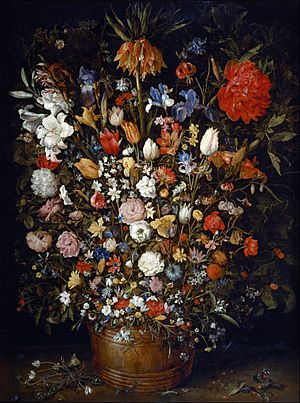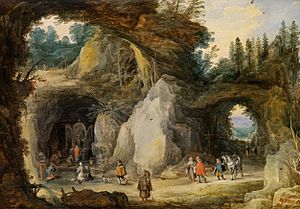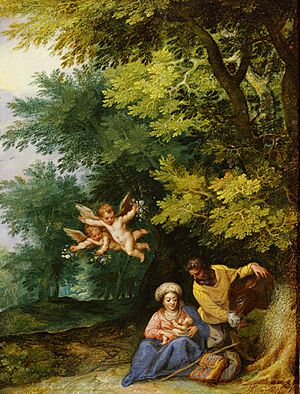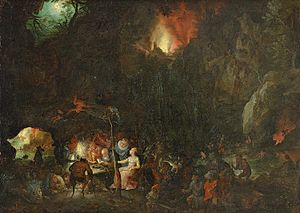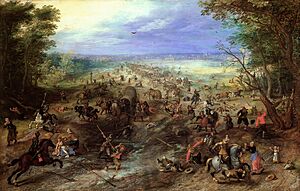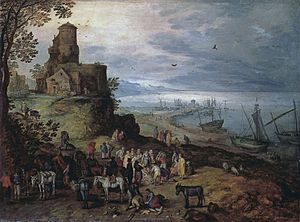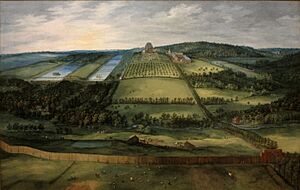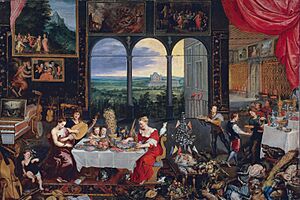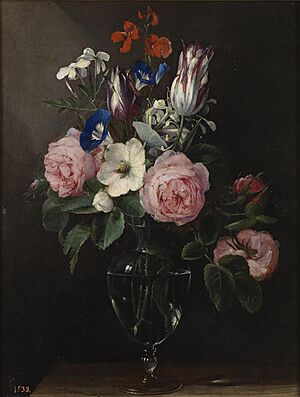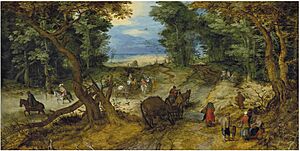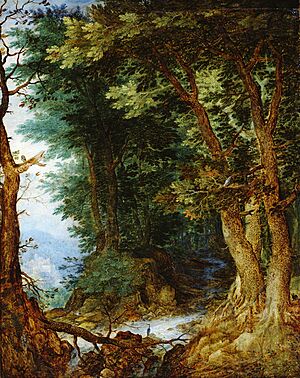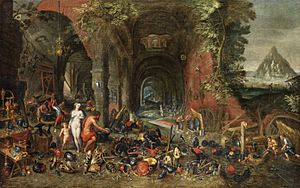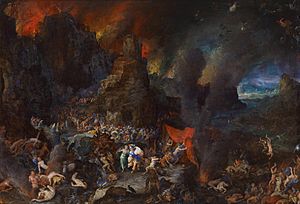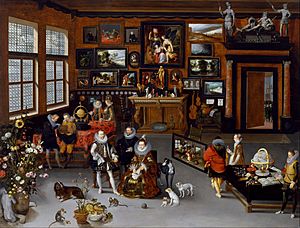Jan Brueghel the Elder facts for kids

Jan Brueghel the Elder (born 1568 – died January 13, 1625) was a famous painter and draughtsman from Flanders. He was the son of Pieter Bruegel the Elder, another very important painter. Jan Brueghel was a close friend and often worked with Peter Paul Rubens. They were two of the most important Flemish painters in the early 1600s.
Jan Brueghel painted many different kinds of pictures. These included history scenes, still lifes of flowers, stories with hidden meanings (allegories), myths, landscapes, and even battle scenes. He was very creative and invented new types of paintings. These new styles included flower garland paintings, paradise landscapes, and gallery paintings. He also painted scenes that were inspired by his father's works, especially village scenes and landscapes with peasants.
People gave Jan Brueghel several nicknames:
- "Velvet" Brueghel: Probably because he was so good at painting fabrics.
- "Flower" Brueghel: Because he was famous for his beautiful flower paintings.
- "Paradise" Brueghel: Because he invented the style of paradise landscapes.
His brother, Pieter Brueghel the Younger, was once called "Hell Brueghel." This was because people thought he painted scary scenes of fire and monsters. However, we now know that many of those paintings were actually done by Jan Brueghel the Elder!
Life of Jan Brueghel
Jan Brueghel the Elder was born in Brussels. His father was Pieter Bruegel the Elder, and his mother was Mayken Coecke van Aelst. Jan's father died when Jan was only about one year old. After his mother died in 1578, Jan and his brother Pieter Brueghel the Younger went to live with their grandmother, Mayken Verhulst. She was also an artist.
Mayken Verhulst taught her grandsons how to draw and paint small pictures with watercolors. Jan and his brother might have also learned from other artists in Brussels who designed tapestries.
Learning to Paint
Jan and Pieter later went to Antwerp to learn oil painting. Jan studied with Peter Goetkint, who was an art dealer. Goetkint died soon after Jan started his training. It's possible Jan continued learning at Goetkint's shop, which his widow took over.
It was common for artists from Flanders to travel to Italy to finish their art studies. Jan Brueghel went to Italy, first visiting Cologne and then Frankenthal. He then traveled to Naples around 1590. In Naples, he made drawings that showed his interest in landscapes and large buildings. He created small, decorative artworks for a nobleman named Don Francesco Caracciolo.
Time in Italy
From 1592 to 1594, Brueghel lived in Rome. He became friends with Paul Bril, a landscape painter from Antwerp who also lived in Rome. Brueghel was inspired by Bril's lively drawings. In Rome, Jan Brueghel also met Hans Rottenhammer, a German painter who made small, detailed paintings. Brueghel worked with both Paul Bril and Rottenhammer. He also drew Rome's ancient buildings, especially the inside of the Colosseum.
Cardinal Federico Borromeo, an important art collector, became Brueghel's friend and supporter for life. Brueghel lived in the Cardinal's palace. When Borromeo became archbishop of Milan in 1595, Brueghel followed him. He painted many landscapes and flower pictures for the Cardinal.
Return to Antwerp
Brueghel stayed in Milan for about a year. In 1596, he returned to Antwerp, where he lived and worked for the rest of his life. In 1597, he became a master in Antwerp's Guild of Saint Luke, which was a guild for artists.
On January 23, 1599, Jan Brueghel married Isabella de Jode. Their son, Jan Brueghel the Younger, was born in 1601. Peter Paul Rubens was his godfather. Jan the Younger later took over his father's art workshop.
In 1601, Brueghel became a citizen of Antwerp. He was then elected as the head of the Guild of Saint Luke.
Family and Later Life
In 1603, his daughter Paschasia Brueghel was born, and Rubens was also her godfather. Sadly, his wife Isabella de Jode died that same year.
In 1604, Brueghel visited Prague, where Emperor Rudolf II, Holy Roman Emperor encouraged new art styles. After returning to Antwerp, Brueghel bought a large house. In April 1605, he married Catharina van Mariënburg. They had eight children, and one of them, Ambrosius Brueghel, also became a painter.
In 1606, Brueghel became a court painter for the Archduke and Duchess Albrecht and Isabella, who ruled the Habsburg Netherlands. He often visited them in Brussels.
Rubens often helped Jan Brueghel with his business. Rubens wrote many letters to Cardinal Borromeo for Brueghel. Rubens even painted a portrait of Jan Brueghel and his family. In 1613, Brueghel went with Rubens and Hendrick van Balen on a trip to the Dutch Republic, where they met other artists.
The city of Antwerp often gave Brueghel important painting jobs. In 1618, he was one of 12 artists chosen to create paintings for the Archduke and Duchess. For this project, Brueghel helped organize a series of paintings about the Allegory of the Five Senses. Other famous artists like Rubens and Frans Snyders worked on this project too.
Jan Brueghel died on January 13, 1625, in Antwerp from a disease called cholera. Rubens helped manage his estate and became the guardian of his children.
His students included his son Jan the Younger and Daniel Seghers. His daughter Paschasia married a painter, and their son Jan van Kessel the Elder also became a painter. Another daughter, Anna, married the famous painter David Teniers the Younger.
Jan Brueghel's Artworks
Jan Brueghel the Elder was a very skilled artist. He painted many different kinds of scenes and introduced new ideas to Flemish art. He helped develop flower still lifes, landscapes, seascapes, and battle scenes. His most famous new styles were flower garland paintings, paradise landscapes, and gallery paintings. Unlike some other artists of his time, he did not paint large altarpieces for churches.
Brueghel was excellent at painting details. He could make materials, animals, and landscapes look very real and precise. He used a special technique that allowed him to show nature very accurately.
Jan Brueghel had a large workshop where many paintings were made and copied. After he died, his son Jan the Younger continued the workshop in the same way. This helped spread Jan the Elder's art widely.
While his brother Pieter made many paintings for the general art market, Jan Brueghel worked for wealthy patrons and collectors. His works, like his paradise landscapes, were often luxury items painted on copper. They were meant for people to enjoy looking at and thinking about.
Working with Other Artists
In 17th-century Antwerp, artists often worked together, especially if they specialized in different types of painting. Jan Brueghel frequently collaborated with other artists because he had many skills.
He worked with:
- Landscape artists like Paul Bril and Joos de Momper.
- Architectural painter Paul Vredeman de Vries.
- Figure painters like Frans Francken the Younger, Hendrick de Clerck, Pieter van Avont, and Hendrick van Balen.
His collaborations with Hans Rottenhammer started in Rome around 1595. Rottenhammer was great at painting people. Often, Brueghel would paint the landscape on a copper plate, send it to Rottenhammer in Venice, who would add the figures, and then send it back. They also created some of the first devotional garland paintings together.
When Brueghel worked with Joos de Momper, their roles were reversed. De Momper painted the landscapes, and Brueghel added the figures. They collaborated on about 59 known paintings, making de Momper his most frequent partner. Hendrick van Balen the Elder was another regular collaborator. They lived close to each other, which made it easy to share their artworks.
Jan Brueghel and Peter Paul Rubens worked on about 25 paintings together between 1598 and 1625. Their first joint work was The Battle of the Amazons. They also created mythological scenes and a series of paintings representing the Five Senses. Their collaboration was special because they had very different styles but could still keep their unique touches in the joint works.
Usually, Brueghel would start a painting, leaving space for Rubens to add the figures. Their joint artworks were highly valued by collectors across Europe.
Ideas Behind His Art
Jan Brueghel's art shows the ideas popular in the Catholic Spanish Netherlands during his time. The Counter-Reformation (a movement to strengthen the Catholic Church) believed that the Earth and its creatures were God's creations. So, studying nature through art and science was encouraged. Cardinal Federico Borromeo, Brueghel's friend, especially loved the beauty of animals. Brueghel's realistic paintings of nature, like flowers, landscapes, and animals, fit perfectly with this idea that studying God's creation helped one understand God.
During Brueghel's time, people also became more interested in studying nature through observation, rather than just old traditions. New animals and plants from newly discovered lands sparked this interest. This led to the first scientific catalogs and encyclopedias, like those by Conrad Gesner and Ulisse Aldrovandi. They created systems to describe and classify animals.
Brueghel's works show this interest in classifying and organizing the natural world. You can see it in his flower paintings, landscapes, and allegorical works. In his paradise landscapes, for example, he grouped animals by their types, like birds or four-legged animals. He also classified them by how they looked and behaved. His paradise landscapes were like visual encyclopedias of animals.
Brueghel's desire to classify the world extended beyond nature. He learned about Emperor Rudolf II's large collections in Prague, which included natural, man-made, and scientific objects. Brueghel's allegorical paintings of the four elements and the five senses also show this classifying interest. He used each element or sense to organize natural, man-made, and scientific objects. His paintings connected the visible world with deeper knowledge, much like how natural historians were starting to distinguish between what they saw and what they knew.
Flower Paintings
Jan Brueghel the Elder was one of the first artists in the Habsburg Netherlands to paint pure flower still lifes. These paintings focus on flowers, usually in a vase, as the main subject. He was very important in developing this type of painting, which is why he was called 'Flower Brueghel'.
While some people thought these flower paintings were symbols of how short life is, it's now more common to see them as simply beautiful and realistic depictions of nature. Brueghel wanted to show his skill in painting nature almost scientifically. These works combined the idea that nature was a revelation of God with a scientific interest in understanding nature.
Brueghel's flower paintings usually show flowers against a dark background. Sometimes, small details like insects or butterflies are added, but the flowers are always the main focus. He often included rare flowers, but also common ones like tulips, irises, and roses. His bouquets usually had flowers that bloom in different seasons, meaning he couldn't have painted them all at once from real life. Brueghel would travel to draw flowers he couldn't find in Antwerp, so he could add them to his bouquets.
He painted each flower with great precision, showing them from different angles with little overlap. Smaller flowers were at the bottom, larger ones in the middle, and tall flowers like lilies at the top.
For example, in his Flowers in a Ceramic Vase (around 1620), the vase has decorations showing sea and corn goddesses. These goddesses often represented water and earth. This combination of the four elements and flowers in one painting can be seen as showing the whole world in a small way.
Brueghel often used the same flower designs in different paintings, but he always made each work feel fresh and lively.
Garland Paintings
Jan Brueghel the Elder was key in creating and developing garland paintings. These paintings typically show a frame or circle of flowers around a religious image or a portrait. Around 1607-1608, he painted the first known garland painting with Hendrick van Balen for Cardinal Federico Borromeo. The Cardinal wanted the painting to honor the Virgin Mary. Brueghel painted the flower garland, and van Balen painted the Virgin Mary in the middle.
This type of painting was inspired by the strong devotion to Mary at the Habsburg court and in Antwerp. Garland paintings were usually collaborations between a still life painter (like Brueghel) and a figure painter. Brueghel worked on garland paintings with Rubens, Frans Francken the Younger, and Pieter van Avont.
An example is the Madonna in Floral Wreath (1621), which he painted with Rubens. Another example is the Garland of Fruit surrounding a Depiction of a Goddess Receiving Gifts from Personifications of the Four Seasons. In this painting, van Balen painted the goddess in the middle, and Brueghel painted the rich garland of flowers, vegetables, and fruits, as well as the surrounding figures and animals.
Landscapes
Jan Brueghel's father, Pieter Bruegel the Elder, was important in developing landscape art. He made his mountain scenes look more natural. Jan continued his father's style of showing people traveling on a road that goes far into the distance. He made figures smaller as they got further away to show depth. He also used different shades of brown, green, and blue to create a sense of distance. His landscapes, with their great depth, are balanced by his focus on the peasants and their simple activities in the foreground.
Like his father, Jan Brueghel also painted many village scenes. He used the landscapes as a setting for crowds of colorful peasants doing various things in the market, on country roads, or at lively festivals. Jan Brueghel's detailed landscape paintings had a big impact on other artists in the early 1600s. His river scenes were known by painters in Haarlem, whom Brueghel might have met during a trip with Rubens in 1613.
Jan Brueghel was also one of the main artists to develop the dense forest landscape in the 17th century. He painted heavily wooded clearings, capturing the thick, mysterious feel of the forest. These scenes often had dark hidden spots, very little open sky, and no clear way for the eye to see beyond the thick trees.
Paradise Landscapes
Jan Brueghel invented the "paradise landscape," which combines landscape painting with animal painting. These paintings usually show many different animals, both exotic and European, living peacefully together in a beautiful, lush landscape. These scenes are inspired by stories from the Bible's Book of Genesis, which tells about the creation of the world and humans. Favorite themes included the creation of man, Adam and Eve in paradise, and animals entering Noah's ark.
Like his flower paintings, these landscapes were influenced by the Catholic Counter-Reformation's view that Earth and its creatures were revelations of God. As mentioned before, Cardinal Federico Borromeo, Brueghel's friend, emphasized the beauty and variety of the animal world. Brueghel tried to show this in his paradise landscapes. The new thing about Brueghel's paradise landscapes was not just the amazing variety of animals (which he studied from real life), but also how he showed them as both part of a religious story and as subjects of scientific order.
Brueghel started developing his paradise landscapes during his time in Venice in the early 1590s. His first known paradise landscape, The Garden of Eden with the Fall of Man, shows the creation of Man in the background, but the main focus is on the animals and the landscape. This was the first paradise landscape where Brueghel "cataloged" animals, showing common and domesticated types. His interest in cataloging animals grew after visiting Emperor Rudolf II, Holy Roman Emperor's court in Prague, which had a large collection of rare animals.
Brueghel continued to improve his paradise landscapes throughout his career. The many versions he created earned him the nickname "Paradise Brueghel."
Allegorical Paintings
Jan Brueghel the Elder made several sets of allegorical paintings, especially on the themes of the Five Senses and the Four Elements. These paintings were often collaborations with other artists. For example, he worked with Rubens on five paintings representing the Five Senses, which are now in the Prado Museum in Madrid. He also worked with Hendrick van Balen on allegorical compositions, like a series on the Four Elements.
In his allegories, Jan Brueghel showed an abstract idea, like one of the senses or elements, through many real objects connected to it. He used detailed images to represent these concepts. For example, in his Allegory of Fire; Venus in the Forge of Vulcan, he included so many details that historians use it to learn about tools used in metalworking in the 17th century.
Scenes of Hell and Demons
Jan Brueghel was nicknamed 'Hell Brueghel' early in his career because of his paintings with demons and hell scenes. An example is The Temptation of St. Anthony, which shows monsters attacking the saint in a dense forest.
Jan Brueghel is thought to have made these hell scenes for a new, educated audience of collectors. To appeal to them, he often used stories from mythology instead of just religious ones. For example, he painted scenes of Aeneas in Hades, guided by the Sibyl. Another theme was Orpheus in the Underworld from Ovid's Metamorphoses. In these paintings, brightly colored monsters created a "fun terror."
Brueghel's hell scenes were influential, and other artists, like Jacob van Swanenburg (one of Rembrandt's teachers), were inspired by them.
Gallery Paintings
Jan Brueghel the Elder and Frans Francken the Younger were the first artists to create paintings of art and curiosity collections in the 1620s. Gallery paintings show large rooms filled with many paintings and other valuable items in fancy settings. These rooms were often called Kunstkammern ("art rooms") or Wunderkammern ("wonder rooms"). The earliest works in this style showed art objects along with scientific tools or unusual natural items. Some gallery paintings also included portraits of the owners or artists at work. These paintings were full of symbols and hidden meanings, showing the intellectual interests of the time. This style quickly became popular.
A famous example of a gallery painting by Jan Brueghel is The Archdukes Albert and Isabella Visiting a Collector's Cabinet (around 1621-1623). This painting is believed to be a collaboration between Jan Brueghel the Elder and Hieronymus Francken II. It shows how people in that time were interested in both art and science. The rooms in these paintings were filled with people discussing scientific tools as much as admiring paintings.
In The Archdukes Albert and Isabella Visiting a Collector's Cabinet, the paintings shown are mostly about the victory of art over ignorance. They refer to the destruction of religious images in the 16th century and the triumph over those who destroyed them during the rule of Archdukes Albert and Isabella. Jan Brueghel painted the large vase of flowers, topped by a sunflower. This sunflower, which turns towards the sun, symbolized how art could grow and flourish under the support of the rulers (who were like the sun).
Singeries (Monkey Scenes)
Brueghel also helped develop the "monkey scene," or "singerie" (a French word meaning a funny face or trick). These are comical paintings where monkeys dress like humans and act like humans. Monkeys were seen as mischievous creatures who were good at imitating people. These paintings of monkeys acting out human roles were a playful way to show the foolishness in the world.
The Flemish artist Pieter van der Borcht the Elder first introduced the singerie as its own theme around 1575. Other Flemish artists, like Frans Francken the Younger and Jan Brueghel the Elder, then picked up this idea. Jan Brueghel the Elder's son-in-law, David Teniers the Younger, became the main artist of this style.
An example of a singerie by Jan Brueghel is Monkeys feasting, from his early years. This painting on copper was likely one of the first singerie paintings. Jan Brueghel probably drew his monkeys at the Archdukes' zoo in Brussels. The painting shows monkeys causing all sorts of trouble, but it also includes a painting above the door called "Ceres and Pan." This painting contrasts the "civilized" world with the "wild" world of the monkeys below.
Images for kids
See also
 In Spanish: Jan Brueghel el Viejo para niños
In Spanish: Jan Brueghel el Viejo para niños


